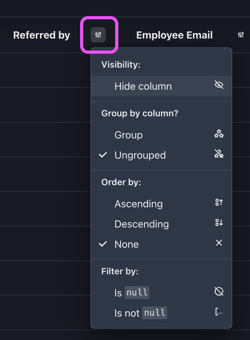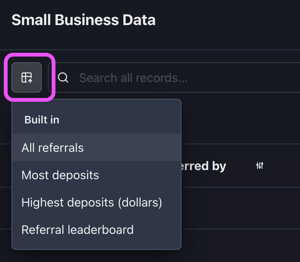Viewing Small Business and Referral Data in the Hub
Admin users can view data about their small business customers (including referral data).
Small business data (including referral data) is accessible by users with Admin role types. This information is more robust than a simple list of customers that were referred to use Autobooks technology.
All data is available for download to a .CSV format. Click the download button in the upper right corner of the data table to download an export. NOTE: exports are limited to no more than 10,000 rows (or your ability to download a certain file size). To create a smaller download file, filter column views to show only the desired meaningful data you need.
Admins can take advantage of the data in a number of meaningful ways, including:
- Create employee referral leaderboards for internal competition;
- Identify customers that are (or aren't) generating TPV dollars for follow-up;
- Schedule customer communications (using our provided email copy or call scripts!) to:
- Encourage enrollments. Send a note to referred customers that have not yet enrolled in Autobooks;
- Get SMBs approved for payment processing: Let enrolled customers that have not provided required Missing Info to log in and do so;
- Encourage usage: Reach out to approved customers that can process payments, but haven't yet;
- Thank your valuable customers: Congratulate your customers on using Autobooks to get paid, and gain feedback on their experience;
You are also able to drill into a specific customer record (click here to jump to the instructions).
Accessing Small Business Data
To view your small business data, log into the Hub and navigate to the Data menu item at left. Expand the Data section, then click on Small Business.

Within the Small Business section, each line item represents a customer that has begun the enrollment process with Autobooks, been referred, or both. You'll see the following information for each small business customer in your list, along with a Search bar at the top to locate a specific item:
- Business Info:
- SMB ID - Autobooks unique customer identifier.
- Integration ID - this is the Autobooks unique identifier for your financial institution. You may have multiple Integration IDs if you have a parent company with affiliated banks, for example.
- Company Name - name of the customer's business.
- External ID - customer's unique identifier from your data core information.
- Email - the email address for the customer that was referred.
- Admin Name - first and last name of the primary admin of the Autobooks account.
- Status - the most recent event in the customer's milestones of their Autobooks journey.
- Business Structure - the type of business structure (ex: Sole Proprietor, LLC).
- Onboard Date - the date the customer accepted Autobooks' terms and conditions.
- Credit Card Limit - the dollar limit the customer has been approved to accept digitally through Autobooks via credit/debit card.
- Subscription Type - this column will indicate if the customer is using the payment modules (Freemium) or the full Autobooks subscription.
- Deboard date - the date a customer has deboarded from Autobooks.
- Deboard reason - the reason a customer has been deboarded from Autobooks. Reasons include:
- Criminal History - uncovered during our initial risk assessment regarding the primary owner, customer cannot be approved to process payments.
- Negative Financial Background - uncovered during our initial risk assessment regarding an owner, customer cannot be approved to process payments.
- Prohibited Business
- Suspected/Confirmed Fraud
- Other - Allow Reboard
- Negative Business Reputation - uncovered during our initial risk assessment regarding the business, customer cannot be approved to process payments.
- SMB Requested - the customer requested that their Autobooks account be closed.
- Other - Do Not Allow Reboard
- Account Closed - the account was closed, usually due to inactivity.
-
- CC Application Info
- CC Application Status - the status of the customer's approval to process credit card payments.
- CC Application Submitted Date - the date/time the customer applied for credit card payment approval through Autobooks.
- CC Application Approved Date - the date/time the customer was approved to process credit card payments through Autobooks.
- ACH Application Info (note: ACH approval dates may differ slightly from credit card processing approval dates)
- ACH Application Status - the status of the customer's approval to process ACH payments.
- ACH Application Submitted Date - the date/time the customer applied for ACH payment approval through Autobooks.
- ACH Application Approved Date - the date/time the customer was approved to process ACH payments through Autobooks.
- Tap to Pay info
- TTP Status - this status indicates if the customer has enabled Tap to Pay within your online banking.
- TTP application date - this is the date/time the customer applied to process payments using Tap to Pay through Autobooks.
- Payment info
- First Payment Date - the date the customer processed their first payment using Autobooks.
- First Payment Amount - the dollar amount of the customer's first payment processed using Autobooks.
- Most Recent Payment Date - the date of the customer's most recent payment processed using Autobooks.
- Most Recent Payment Amount - the dollar amount of the customer's most recent payment processed using Autobooks.
- Total Payment Count - the number of times an Autobooks payment deposit has been made to the customer's account.
- Total Payment Amount - the total dollar amount the customer has processed in payments through Autobooks.
- Referral info
- Referral ID - this is the Autobooks-assigned number for the referral submitted.
- Referred By - the name of the employee that referred the customer.
- Employee Email - your employee's email address that referred the customer.
- Referral date - the date the employee submitted the referral through the Autobooks Hub.
Sorting and Viewing Small Business Data
Small business data may be sorted and filtered in a number of ways. You can:
- Sort and filter data per column - each column within the small business data table can be sorted and filtered as needed. Simply click the icon in a column header, and a dropdown of sort/filter options will appear.

- Select data from default options - you may also view various pre-canned views from a list of default view options. Click the Table Settings icon to the left of the search bar, and a list of views will appear to choose from.

Default Options Include:
- All referrals - shows all customers that were referred by an employee.
- Most deposits - customers with deposit activity, sorted from most to least number of deposits.
- Highest deposits (dollars) - customers with the highest dollar deposit activity, sorted from most to least in dollars.
- Referral leaderboard - referral activity per employee, sorted from employee with the most referrals to least.
Viewing a customer's Company record
You can drill into any Company Name within the Small Business Data or in the Progress Center to see more detail about that customer's Autobooks journey. To access more detail:
- Click the Company Name. NOTE: There will be no link to click if the customer has not yet accepted Autobooks' terms and conditions.
- The first two sections of information that appear are Status and Contacts.
- Status - lists all of milestones that have occurred within the customer's Autobooks progress including date terms were accepted, when the customer's data was submitted for payment enablement approval, when the application was approved, and when the customer processed their first payment.
- Contacts - lists all contacts Autobooks has for that business record. The contact email and phone numbers will be listed, including their user roles.
 The next two sections that appear are Basic Info and Processing Limits.
The next two sections that appear are Basic Info and Processing Limits.
- Basic Info - lists the SMB ID, Company Name, Business Structure, NAICS code, Zip code, and what Autobooks' plan the customer is currently enrolled in (full or free).
- Processing Limits - lists the processing limits for credit card and ACH transactions.
- Credit Card Single Transaction Limit (Review) - this limit indicates the dollar threshold in which a customer's payment will be held for review. For example, if the limit indicates $3,000 Autobooks will hold and review any payments exceeding that amount.
- Credit Card Single Transaction Limit - this limit indicates the maximum dollar amount the customer can process through Autobooks in a single transaction.
- ACH Single Transaction Amount - this limit indicates the maximum dollar amount a customer can process in a single transaction via ACH.
- ACH Single Day Transaction Amount - this limit indicates the maximum dollar amount a customer can process in a single DAY via ACH.
- ACH Single Day Transaction Count - this limit indicates the maximum number of ACH transactions the customer can accept in a single day.

- The last two sections of information are Payment Sources and Payment Table.
- Payment Sources - this list will show the number of payments taken through each Autobooks payment tool and the total dollar amount of those transactions.
- Payment Table - this table breaks down each payment taken by the customer and its attributes.
